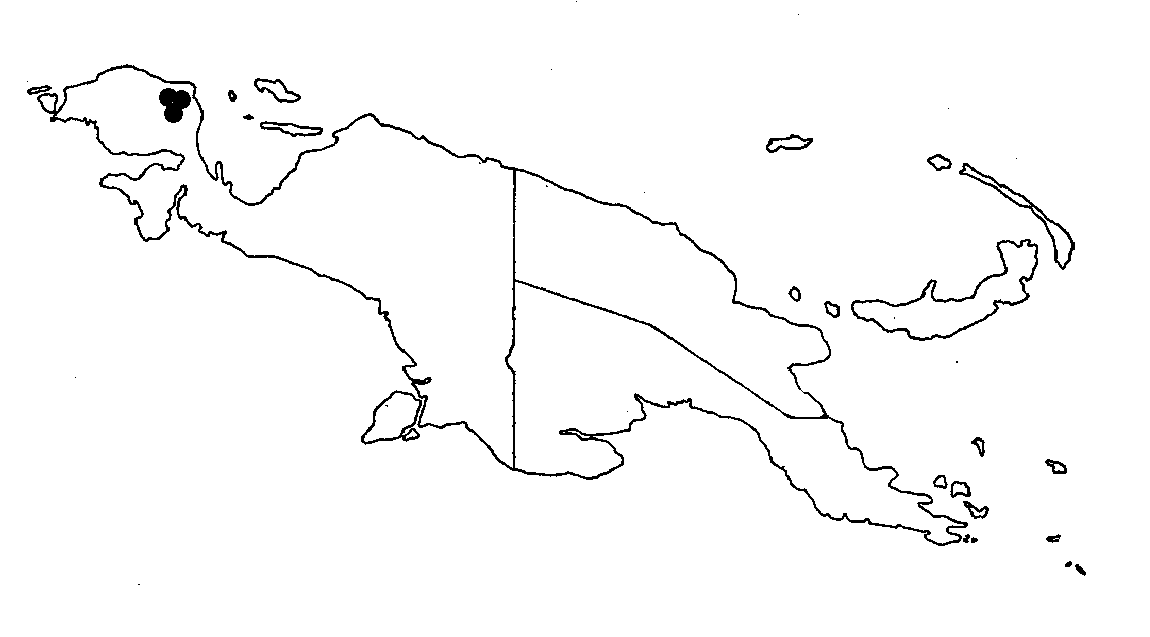
Distribution Map

Description (Barlow 1992)
Amyema kebarensis Barlow, Austral. J. Bot. 22 (1974) 579. - Type: van Royen & Sleumer 8256 (holo L 963.204-39; iso CANB 131383), New Guinea, Vogelkop. Kebar Valley, opposite Andjai, 700 m. on Vaccinium cavendishoides and Trochocarpa laurina. 19.xii.1961.
For description see Barlow, Austral. J. Bot. 22 (1974) 579. Amyema kebarensis has few specialized characters and thus presents a relatively generalized facies for the genus. It can be distinguished locally by its very slender habit. its small, thin, very narrow acuminate leaves, 3- or 4-rayed umbel of triads, and 4-merous corolla. The flower colour is described as red or purple in the lower part and green or yellow above.
Amyema kebarensis is known only from the Vogelkop, Irian
Jaya (fig. 9; 5 collections seen), from 700 to 2100 m elevation.
Habitat details are poorly known; recorded hosts are Clethra
sp., Vaccinium cavendishoides, and Trochocarpa laurina.
The species is probably a young local endemic, but its affinities
are difficult to assess.
Description (Barlow 1974)
Amyema kebarense Barlow, sp. nov.
Type-West Irian, Kebar Valley, above Sulphur Springs opposite Andjai, 700 m alt., van Royen and Sleumer 8256, 19.xii.1961 (L 96320439; CANB 131383).
Frutex parvus, ramisissimus, stolonibus numerosis
gracilibus. Inflorescentia calyx corollaque pilis paucis dissitis
vestitis; ceterum glaber. Rami graciles, lenticellis elongatis
pustulati. Folia opposita; lamina anguste lanceolata, 4-7 cm longa,
0.4 - 0.7-(l.3) cm lata, apice acuminata acuta, paginis obscuris,
revoluta ubi sicca, basi in petiolum 1-3 mm longum sensim attenuata.
Inflorescentiae 1-3 in axillis ortae, pedunculatae, umbellatae;
umbellae 3- (vel 4-) radiatae; radiis apice trifloris, fore mediano
sessili lateralibus pedicellatis; pedunculus gracilis, (8)-l0-l5-(20)
mm longus; radii c. 8 mm longi; pedicelli in statu florendi
2-3 mm longi, in statu fructi-fero longiores; bracteae parvae,
obtusae, patulae, 1 mm longae. Calyx angustus, leviter infundibuliformis,
2 mm longus; limbus c. 0.3 mm longus. Corolla in alabastro
maturo gracilissima, apice rotundata pilis paucis dissitis albis,
4-mera, c. 18 mm longa. Antherae acutae, 2 mm longae; pars
liberae filamentae 4 mm longae. Fructus prope globularis, 6 mm
longus.
Small much-branched shrub with many slender runners, glabrous
except for a few scattered hairs on the inflorescence, calyx and
corolla. Stems terete, slender, pustulate with elongate lenticels.
Leaves opposite; petiole 1-3 mm long; lamina narrow lanceolate,
rolled when dry, 4-7 by 0.4-0.7 (l.3) cm, dull on both sides,
gradually attenuate at the base, acuminate and acute at the apex;
venation invisible. Infiorescences 1-3 in the axils; peduncle
slender, (8)-l0-l5-(20) mm long; rays 3 (or 4), slender, wider
towards the apex, often curved, c. 8 mm long; pedicels
of the lateral flowers of the triads 2-3 mm long in flower but
longer in fruit; bracts small, spreading, obtuse, 1 mm long. Calyx
narrow, slightly funnel-shaped, 2 mm long; limb only c. 0.3
mm long. Corolla in the mature bud very slender, with a
few scattered white hairs at the tip, rounded at the apex, c.
18 mm long, 4-merous. Anthers acute, 2 mm long; free parts
of the filaments 4 mm long. Fruit nearly globular, 6 mm long.
Occurrence. Kebar Valley, Vogelkop Peninsula, West Irian (Fig. 6), 700 to 2100 m altitude. The only recorded host is Clethra sp.
Specimens Examined. WEST IRIAN: Kebar Valley, Nertoi (opposite Andjai) to Mt. Tobi, 700 m alt., van Royen and Sleumer 6845, 11 .x. 1961 (L); Kebar Valley, Watjetoni Mt., 1200 m alt., Versteegh BW 10330, 23.xi.1960 (L); Arfak Mts., Anggi Gita Lake to Mt. Koebre, 2100 m alt., Sleumer and Vink 4297, 16.i.1962 (L; LAE).
While Amyema kebarense has no unique
diagnostic characters, it is distinguished from most of its congeners
by its slender habit, small narrow leaves and 4-merous flowers.
It is a well-defined and sharply distinct species, but its lack
of specialized characters makes its affinities difficult to assess.
Illustrations
Photographs
Amyema kebarensis
updated 18 January 2007